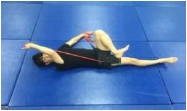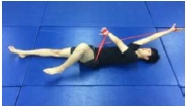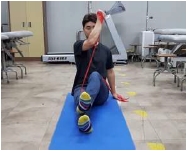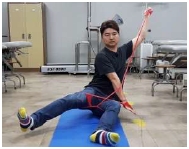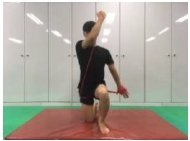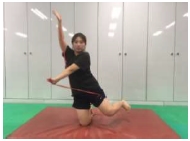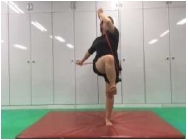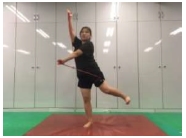
Effect of CLX Training Combined with PNF Pattern on Balance Ability
© 2019 by the Korean Physical Therapy Science
Abstract
PNF patterns are the basis of human motion and can be expected to improve joint motion and coordination. Combined physical training with CLX training and PNF patterns can help to improve balance and perform functional mobility in the lower limb. The purpose of this study is to confirm the effect of CLX training combined with PNF pattern on balance ability.
Randomized Controlled Trial.
Total 16 persons participate in this study and were randomly divided in two groups the experimental group and control group. In the experimental group, exercise program with PNF pattern and CLX was performed total 24 times for 8 weeks. In the exercise program, the PNF pattern composed of D1F and D2F was applied with CLX in five positions. Single limb hop test, Y-balance test and Balance Error scoring system were performed to evaluate the balance ability according to the interventions.
In the single limb hop, the experimental group revealed a significant difference than a control group (p<0.05).The result of balance error scoring system, experimental group revealed significant differences between before and after training and revealed significant differences than a control group (p<0.05). In the Y-balance test, the experimental group revealed significant differences than a control group in both side.
The results of this study showed that the CLX exercise in combination with the PNF pattern had a positive effect on enhancing the balance ability of the normal adult and performing the functional mobility of the lower limb.
Keywords:
Balance, Coordination, Theraband, Resistive trainingⅠ. Introduction
Balance of the trunk means the ability to move and maintain the center of gravity of the body using the spine and trunk. The ability to control the trunk is a key physical ability required for various functional tasks in daily life and is an important factor for predicting the level of participation in walking and functional daily life after impairment of body function like stroke patients (Hsieh, Sheu, Hsueh, & Wang, 2002). Improvement of trunk control capacity can enhance balance and gait quality and positively affect the use of upper limb function among the many activities performed in daily activities (Fairbank, Couper, Davies, & O'Brien, 1980). In addition, it is known that the coordinated motion of the trunk can contribute to dynamic stability of the spinal segment by promoting balance of the dynamic posture and facilitating the trunk muscle (Miyake, Nakamura, & Nakajima, 2014).
The proprioceptive neuromuscular fascilitation (PNF) is a therapeutic approach designed to promote exercise control based on the activity of proprioceptive sensory organs that provide information about body movements and postures. In the PNF, the movement is characterized by a spiral and a diagonal direction, which is known as the basic pattern of motions required for functional activity (Luke, Dodd, & Brock, 2004). Balance is defined as the ability of the body to keep the body in a stable position in a situation where it is not moving or moving. The PNF approach has been reported to have an effect of increasing balance capacity, including strength, flexibility, and balance (Mirek et al., 2015; Seo & Kim, 2015).
The purpose of this study is to investigate the effect of exercise combined with PNF pattern and elastic band on the balance ability and agility of normal adults.
Ⅱ. Methods
1. Subjects
This study was conducted in normal adults. A total of 16 persons were selected according to the selection criteria and the exclusion criteria. All subjects agreed to participate in the experiment after receiving explanation about the whole experiment. The criteria for selection of this study were adults between 20 and 29 years old and the person who had no balance restriction due to musculoskeletal impairments such as fractures and neurological impairments including sensory organs. Subjects were randomly divided into experimental group and control group.
2. Experimental Procedure
Subjects who were included in the experimental group performed a combined exercise of looped elastic band CLX (consecutive loop exercise) and PNF pattern for 30 minutes every 3 weeks for 8 weeks after the pre-evaluation <Table 1>.
The exercise program of the experimental group was conducted in five poses in a lying position, a long sitting position, a kneeling, a kneeling to standing, and a standing position. The PNF pattern was applied to both the upper and lower limbs by each posture, and D1 and D2 patterns were combined <Table 2>.
When performing PNF pattern exercise in five poses, CLX CONSECUTIVE LOOPS (CLX, THERABANDTM), which is a loop-shaped elastic band, was worn on the wrists of both upper and lower limbs of the participants. Unlike other elastic bands, CLX has a loop-shaped space in the band, so it can easily provide anchorage point without having to tie it separately for fixation during band exercise, and it provides simultaneous resistance to multiple joints. For each positions, we performed a CLX + PNF pattern for 5 minutes and then gave a rest for 1 minute. We announced that could stop immediately if there were symptoms such as dizziness or nausea during exercise.
Participants in the control group performed a post - evaluation after 8 weeks without any further intervention after the pre - evaluation and observed changes in their balance and coordination abilities. One of the participants in the control group dropped out of the group, There are seven people who have finally finished.
3. Assessment tools
The balance error scoring system (BESS) measures three postures. It is composed of two-leg stance, one-leg stance and tandem stance, and measurement is performed on the unstable surface in the same manner after the measurement on the flat ground. The total score of the test is 60 points, which means that the lower the total score, the better the subject's balance ability. For each posture, the maximum error score is 10points, and the score of each posture is summed up to represent the total score. The retest reliability was 0.70 and the interclass reliability was ICC=0.96 (Bell, Guskiewicz, Clark, & Padua, 2011).
The Y-balance test is an assessment method designed to predict the risk of injury to the general public or athletes and can be used to measure effectiveness and balance and coordination in the rehabilitation process. Each participant should have one leg standing in the middle of the three segmented mark on the floor and then stretch the other leg as far as possible in an anterior, posterolateral, and posteromedial directions. Measure the distance to the point where the toe of the outstretched foot is located while maintaining a balance of standing. The distance between the three directions measured on each foot was converted to a standard score for analysis (Myers, Christopherson, & Butler, 2018).
Single limb hop test (SLHT) was performed to evaluate coordination, strength, and balance ability. For the measurement, the subjects placed one leg standing in the starting line and measured the distance by forward jumping as far as possible. The best records were used for the analysis by performing each of the legs three times each. The inter-reater reliability of the single limb hop test is 0.75 (Sawle, Freeman, & Marsden, 2017).
4. data analysis
All data are described using mean and standard deviation. Paired t test was performed to compare before and after each group. Independent t test was used to compare the intergroup effects of intervention. All statistical significance levels were set at 0.05
Ⅲ. Results
1. General characteristics of subjects
The general characteristics of participants in this study are as follows. There were no significant differences in the height, weight, age, BMI, and sex composition of the participants between the groups <Table 3>.
2. Comparison of BESS
The experimental group showed a significant differences from 28.37 points to 12.87 points, but no significant differences was observed in the control group. In the comparison between the groups according to the intervention, the experimental group showed a more significant difference than the control group <Table 4>.
3. Comparison of Y-balance test
The Y-balance test on the left side showed a significant difference from 69.72 points to 104.25 points in the experimental group and the control group also showed a significant difference from 67.14 to 77.50. In the comparison between the groups according to the intervention, the experimental group showed a more significant difference than the control group. The Y-balance test on the right side showed a significant difference from 70.29 to 103.34 in the experimental group and a significant difference from 67.34 to 79.06 in the control group. In the comparison between the groups according to the intervention, the experimental group showed a more significant difference than the control group <Table 5>.
4. Comparison of Single limb hop test
In the SLHT on the left side, the experimental group increased numerically from 135.25cm to 140.62cm, but there was no significant difference. In the comparison between the groups according to the intervention, the experimental group showed a more significant difference than the control group. In the SLHT on the right side, the experimental group showed a significant difference from 139 cm to 141 cm before the experiment. In the comparison between the groups, the experimental group showed a more significant difference than the control group <Table 6>.
Ⅳ. Discussion
In order to perform various tasks required in everyday life, training of basic physical strength is an important factor, and maintenance and improvement of fitness including agility and coordination from normal adults to elderly people are essential(Clark, Vandermorris, & Heisz, 2015). The purpose of this study was to investigate the effect of a combination of PNF pattern and CLX, a looped elastic band, on balance ability and agility.
BESS was performed to evaluate the change of balance ability through core muscle strengthening. In this study, the experimental group showed a significant differences in balance ability compared to the control group. Mikesky(1994) suggests that progressive resistance exercise using elastic bands, which can provide appropriate loadings to individual body capacities, is helpful in maintaining myocardial function despite age-related muscle fiber and muscle strength reduction (Mikesky, Topp, Wigglesworth, Harsha, & Edwards, 1994). In this study, we used CLX, which contains continuous loops in the band. Compared to the control method of load change according to the band color and the change of fixed point position in general elastic band, CLX is able to easily select the position of the ring to be fixed to the wrist or ankle during exercise, It is thought to be much more efficient in controlling the load according to individual exercise capacity. Resistance can induce muscle tension in areas of weakness. This effect is referred to as dissipation, which can occur not only within the limb but also between the muscles between the extremities (S.S., D., & M., 2008).
In this study, when the PNF pattern is performed, elastic bands corresponding to the strength level of the participant are selected and the position of the fixed point is adjusted appropriately. This method of applying the elastic band was effective in providing appropriate load when performing various patterns by posture. In addition, it is considered that it was effective to provide a irradiation effect to the trunk and limb muscles by appropriately providing resistance direction.
In this study, the Y-balance test conducted was performed to evaluate the dynamic balance and the functional symmetry of limb function. The PNF pattern performed by the participants in this study is a sprinter pattern and a skate pattern that are applied to the D1 and D2 pattern components. The PNF pattern is the basis for human functional activity. The sprinter pattern and the skater pattern are combined with the PNF patterns of the upper and lower limbs and are known to induce coordinated and functional movements (S.S. et al., 2008). The splinter pattern is induced simultaneously with flexion-adduction-lateral rotation of the shoulder joint and lateral-superior-anterior movement of the scapular inferior angle. It also induces extension-abduction-interanal rotation of the ipsilateral hip joint and inferior-posterior-lateral movement of the ischial tuberocity. And The extension-abduction-internal rotation of the shoulder joint and the movement of the scapular inferior angle in the posterior-inferior-internal rotation direction are simultaneously induced. It also has the effect of inducing flexion, adduction, internal rotation and ischial tuberocity of the ipsilateral hip joint in the anterior-superior-medial direction (Guiu-Tula, Cabanas-Valdes, Sitja-Rabert, Urrutia, & Gomara-Toldra, 2017; Nakada et al., 2018). In this study, participants were asked to perform the resistance exercise combined with CLX in five positions such as supine, long sitting, kneeling and standing position. The characteristics of the exercise method in this study are the increase effect of the upper and lower muscle activities by applying the PNF pattern combined with CLX exercise simultaneously. In the Y-blance test, the control group was 77.5 points in the left lower limb and 79.6 points in the right lower limb. In the experimental group, the difference was significant in the left lower limb 104.2 points and the right lower limb 103.3 points. In the SLHT results, the experimental group increased from 135.3cm to 140.6cm in the left lower limb and increased from 139cm to 141.9cm in the right lower limb, the experimental group showed more significant differences than the control group. These results exceeded the 19.5 point, which is the reference point of the minimally clinically important difference of the Y-blance test, suggesting that the improvement of muscle strength and coordination ability in the experimental group was significantly symmetrically increased.
The limitations of this study are as follows. First, the number of samples is too small to generalize the results of this study on the basis of normal adult subjects. Second, the control group of this study did not receive any intervention for 8 weeks after the pretest. Because there was no intervention of the control group to compare the intervention effect of the experimental group, the factor should be considered.
Ⅴ. Conclusion
The purpose of this study was to investigate the effect of PNF exercise combined with CLX band on the change of balance, coordination and agility in 20 normal adults. The results of the study showed that the experimental group showed significant changes in balance, coordination and agility compared to the control group. Based on this, it is possible to suggest an resistance exercise based on PNF exercise combined with CLX to induce the balance, coordination and agility required at the level of daily living.
Reference
-
Bell, D. R., Guskiewicz, K. M., Clark, M. A., & Padua, D. A. Systematic review of the balance error scoring system. SportsHealth. 2011;3(3):287-295.
[https://doi.org/10.1177/1941738111403122]

-
Clark, I. B., Vandermorris, S., & Heisz, J. J. Physical fitness and sociocognitive engagement are associated with different aspects of cognition in older adults. JAmGeriatrSoc. 2015;63(1):177-179.
[https://doi.org/10.1111/jgs.13215]

- Fairbank, J. C., Couper, J., Davies, J. B., & O'Brien, J. P. The Oswestry low back pain disability questionnaire. Physiotherapy. 1980;66(8):271-273.
-
Guiu-Tula, F. X., Cabanas-Valdes, R., Sitja-Rabert, M., Urrutia, G., & Gomara-Toldra, N. The Efficacy of the proprioceptive neuromuscular facilitation (PNF) approach in stroke rehabilitation to improve basic activities of daily living and quality of life: a systematic review and meta-analysis protocol. BMJOpen. 2017;7(12):e016739.
[https://doi.org/10.1136/bmjopen-2017-016739]

-
Hsieh, C. L., Sheu C.f., Hsueh, I. P.,Wang, C.-H. Trunk control as an early predictor of comprehensive activities of daily living function in stroke patients. Stroke. 2002;33(11):2626-30.
[https://doi.org/10.1161/01.STR.0000033930.05931.93]

-
Luke, C., Dodd, K. J., & Brock, K. Outcomes of the Bobath concept on upper limb recovery following stroke. ClinRehabil. 2004;18(8):888-898.
[https://doi.org/10.1191/0269215504cr793oa]

-
Mikesky, A. E., Topp, R., Wigglesworth, J. K., Harsha, D. M., & Edwards, J. E. Efficacy of a home-based training program for older adults using elastic tubing. EurJApplPhysiolOccupPhysiol. 1994;69(4):316-320.
[https://doi.org/10.1007/BF00392037]

-
Mirek, E., Filip, M., Banaszkiewicz, K., Rudzinska, M., Szymura, J., Pasiut, S., . Szczudlik, A. The effects of physiotherapy with PNF concept on gait and balance of patients with Huntington's disease - pilot study. NeurolNeurochirPol. 2015;49(6):354-357.
[https://doi.org/10.1016/j.pjnns.2015.09.002]

-
Miyake, Y., Nakamura, S., & Nakajima, M. The effect of trunk coordination exercise on dynamic postural control using a Core Noodle. J Bodyw Mov Ther. 2014;18(4):519-25
[https://doi.org/10.1016/j.jbmt.2013.12.005]

-
Myers, H., Christopherson, Z., & Butler, R. J. Relationship between the lower quarter Y-balance test scores and isokinetic strength testing in patients status post acl reconstrunction. IntJSports PhysTher. 2018;13(2):152-159.
[https://doi.org/10.26603/ijspt20180152]

-
Nakada, C. S., Meningroni, P. C., Ferreira, A. C. S., Hata, L., Fuzaro, A. C., Junior, W. M., & de Araujo, J. E. Ipsilateral proprioceptive neuromuscular facilitation patterns improve overflow and reduce foot drop in patients with demyelinating polyneuropathy. JExercRehabil. 2018;14(3):503-508.
[https://doi.org/10.12965/jer.1836178.089]

- S.S., A., D., B., & M., B. PNF in practice: An Illustrated guide. 3rd edition. Springer; 2008.
- Sawle, L., Freeman, J., & Marsden, J. Intra-rater reliability of the multiple single-leg hop-test and relationships with age, leg dominance and training. IntJSportsPhysTher. 2017;12(2):190-198.
-
Seo, K. C., & Kim, H. A. The effects of ramp gait exercise with PNF on stroke patients' dynamic balance. JPhysTherSci. 2015;27(6):1747-1749.
[https://doi.org/10.1589/jpts.27.1747]


